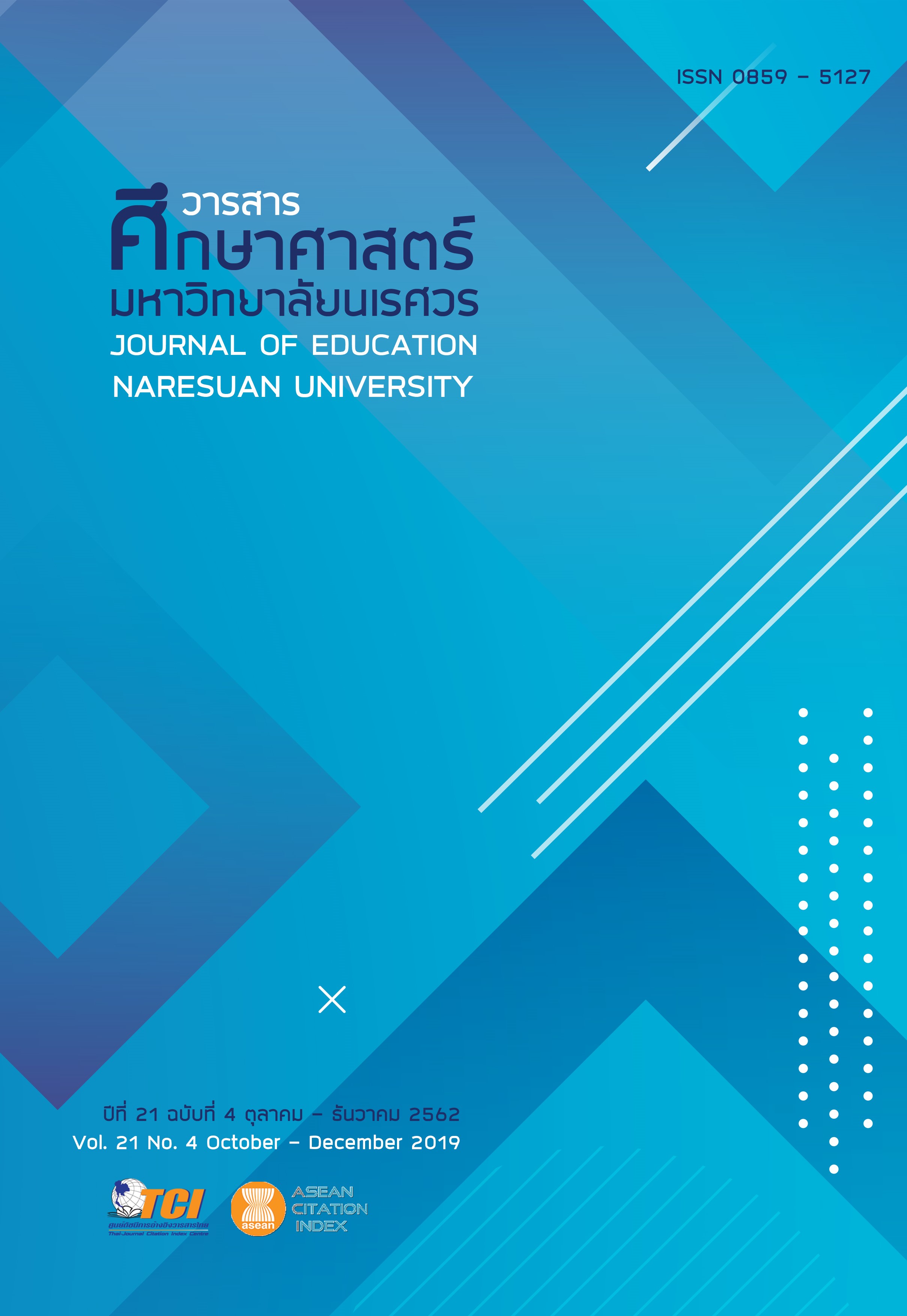ผลการจัดกิจกรรมการเรียนรู้วิทยาศาสตร์ เรื่อง แสงและการมองเห็น ตามแนวทางสะเต็มศึกษา สำหรับนักเรียนระดับมัธยมศึกษาตอนต้น (EFFECT OF SCIENCE LEARNING ACTIVITY ON LIGHT AND VISIBILITY BASED ON STEM EDUCATION FOR LOWER SECONDARY STUDENTS)
Main Article Content
Abstract
การวิจัยนี้มีวัตถุประสงค์เพื่อ 1) สร้างชุดกิจกรรมการเรียนรู้วิทยาศาสตร์เรื่องแสงและการมองเห็นตามแนวทางสะเต็มศึกษาและประเมินคุณภาพโดยผู้เชี่ยวชาญ 2) เปรียบเทียบผลสัมฤทธิ์ทางการเรียนของนักเรียนที่เรียนด้วยชุดกิจกรรมการเรียนรู้วิทยาศาสตร์เรื่องแสงและการมองเห็นตามแนวทางสะเต็มศึกษาระหว่างก่อนเรียนและหลังเรียน 3) ศึกษาผลการเรียนรู้ของนักเรียนที่ได้รับการจัดการเรียนรู้โดยใช้ชุดกิจกรรมเปรียบเทียบกับเกณฑ์ร้อยละ 70 ที่กำหนด และ 4) ศึกษาความพึงพอใจของนักเรียนที่มีต่อการเรียนด้วยชุดกิจกรรมวิทยาศาสตร์ตามแนวทางสะเต็มศึกษา กลุ่มตัวอย่างที่ใช้ในการวิจัยเป็นนักเรียนชั้นมัธยมศึกษาปีที่ 1 โรงเรียนเลิงนกทา จังหวัดยโสธร จำนวน 1 ห้องเรียน มีนักเรียนจำนวน 35 คน โดยเลือกแบบเจาะจง เครื่องมือที่ใช้ในการวิจัย ได้แก่ 1) ชุดกิจกรรมการเรียนรู้วิทยาศาสตร์เรื่องแสงและการมองเห็นตามแนวทางสะเต็มศึกษา 2) แบบประเมินผลงานนักเรียน 3) แบบทดสอบวัดผลสัมฤทธิ์ทางการเรียนเรื่องแสงและการมองเห็น และ 4) แบบสอบถามความพึงพอใจของนักเรียนที่มีต่อการเรียนด้วยชุดกิจกรรมวิทยาศาสตร์เรื่องแสงและการมองเห็น การวิจัยนี้เป็นการวิจัยเชิงทดลองใช้แบบแผนการวิจัยแบบกลุ่มเดียวที่มีการทดสอบก่อนเรียนและหลังเรียน ร่วมกับการศึกษาผลการเรียนรู้ระหว่างเรียนของนักเรียนโดยการประเมินตามสภาพจริง สถิติที่ใช้ในการวิเคราะห์ข้อมูล ได้แก่ ค่าเฉลี่ย ส่วนเบี่ยงเบนมาตรฐาน ค่าร้อยละ และการทดสอบค่าทีแบบตัวอย่างไม่อิสระต่อกัน ผลการวิจัยสรุปได้ ดังนี้ 1) ผลการประเมินคุณภาพชุดกิจกรรมโดยผู้เชี่ยวชาญมีคุณภาพอยู่ในระดับมาก ( = 4.13, S.D. = 0.20) 2) ผลสัมฤทธิ์ทางการเรียนของนักเรียนหลังเรียนสูงกว่าก่อนเรียนอย่างมีนัยสำคัญทางสถิติที่ระดับ.05 3) ผลการเรียนรู้ของนักเรียนที่ประเมินตามสภาพจริงมีคะแนนเฉลี่ยคิดเป็นร้อยละ 75.75 ซึ่งสูงกว่าเกณฑ์ร้อยละ 70 ที่ตั้งไว้อย่างมีนัยสำคัญทางสถิติที่ระดับ .05 และ 4) ผลการศึกษาความพึงพอใจของนักเรียนที่มีต่อการเรียนด้วยชุดกิจกรรมการเรียนรู้วิทยาศาสตร์เรื่องแสงและการมองเห็นอยู่ในระดับพึงพอใจมากที่สุด (
= 4.71, S.D. = 0.88)
EFFECT OF SCIENCE LEARNING ACTIVITY ON LIGHT AND VISIBILITY BASED ON STEM EDUCATION FOR LOWER SECONDARY STUDENTS
The purposes of this study were 1) to develop the science learning activity packages on light and visibility based on STEM Education and to assess the quality of the activity packages by experts, 2) to compare students’ learning achievement before and after learning, 3) to study learning outcomes of the students to meet the 70 criteria, and 4) to study the students’ satisfaction towards learning. The sample group was one classroom of 7th grade students (n = 35) of Loengnoktha School, Yasotorn Province. The research tools consisted of 1) the science learning activity packages on light and visibility based on STEM Education for lower secondary students, 2) the students’ work assessment forms, 3) the learning achievement test, and 4) the students’ satisfaction questionnaire. This research is an experimental research using the research design of one group pretest-posttest design and using authentic assessment. The statistics used for analyzing the collected data were mean, standard deviation, percentages, t-test for dependent samples, and t-test for one samples including using authentic assessment. The result indicated that: 1) the quality of the activity packages by the experts was at level of good quality ( = 4.13, S.D. = 0.20), 2) the mean scores of learning achievement of posttest were higher than those of pretest at the statistically significant .05 level, 3) the learning outcomes of the students measured from the authentic assessment were mean scores at 75.75 percent, which were higher than 70 percent of criteria at the statistically significant .05 level, and 4) the students’ satisfaction towards learning with the activity packages was at very good level (
= 4.71, S.D. = 0.88).
Article Details
The owner of the article does not copy or violate any of its copyright. If any copyright infringement occurs or prosecution, in any case, the Editorial Board is not involved in all the rights to the owner of the article to be performed.
References
2. Chaolumbua, S., & Hemaprosit, S. (2015). Development of an additional STEM Integrated science curriculum on Sugarcane for the 9th Grade Students. Journal of Education, 26(1), 224-236. [in Thai]
3. Dechakoop, P. (2015). 21st century learning. Bangkok: Chulalongkorn University Printing House. [in Thai]
4. Inta, K., Chaiworn, P., & Ratchawet A. (2015). The learning activity packages creation with the title “Amazing Rubber” by using STEM Education curriculum and 21st century skills development for secondary education level. Journal of faculty of Education Pibulsongkram Rajabhat University, 1(Special), 132-141. [in Thai]
5. Intalapaporn, J., Patphol, M., Wongyai, W., & Srisamorn Pumsa-ard, S. (2015). The study guidelines for learning management of the STEM Education for elementary students. Veridian E-Journal, Silpakorn University, 8(1), 62-74.
6. Intanon, B. (2008). A study on science learning achievement and ability in solving science problems through problem-based learning and Inquiry process of Matthayomsuksa 3 Students at Yotinbumrung School (Master thesis). Bangkok: Srinakharinwirot University. [in Thai]
7. Julawatthanathon, M. (2013). A study of science technology engineering and mathematics education or STEM Education. Journal of Science Teacher Association of Thailand, 9(January-December), 3-14.
8. Kaewsingam, T. (2012). Effects of using the 4EX2 instructional model on concepts about light and vision and skills in interpreting data and making conclusion of lower secondary school students (Master thesis). Bangkok: Srinakharinwirot University. [in Thai]
9. Kijkuakul, S. (2015). STEM Education. Journal of Education Naresuan University, 17(2), 201-207. [in Thai]
10. Lertangkoon, C., Paewponsong J., Wadeesirisak, S., & Koocharoenpisal, N. (2015). The development of science activity packages on food contaminant testing for the 8th grade students. Srinakharinwirot Science Journal, 31(1), 65-82. [in Thai]
11. Lhungdee, S. (2009). The results of learning activities by using inquiry learning to understand concept and satisfaction science subject on light and visuality of Mathayomsuksa 2 students (Master thesis). Khon Kaen: Khon Kaen University. [in Thai]
12. Ministry of Education. (2008). The Basic education core curriculum B.E. 2551. Bangkok: Kurusapa Printing Ladphrao. [in Thai]
13. Ministry of Education. (2014). Guidebook STEM Activities. Bangkok: Ministry of Education. [in Thai]
14. Muangkrajang, S., Thaiklang, S., Pimnoo, P., & Koocharoenpisal, N. (2015). Implementation of the science activity package on forces and motion to enhance basic science process skills of 9thgrade students. Srinakharinwirot Science Journal, 31(2), 99-116. [in Thai]
15. Panich, V. (2012). The way to build learning for students in the 21st century. Bangkok: Tathata Publication. [in Thai]
16. Saengpromsri, P., Nuangchalerm, P., & Chantiratikul, P. (2015). Comparisons of learning achievement, integrated science process skills, and attitude towards chemistry learning for Matthayomsueksa 5 students between STEM education and conventional methods (Master thesis). Maha Sarakham: Mahasarakham University. [in Thai]
17. Siriputtrachai, P. (2013). STEM Education and 21st century skills development. Executive Journal, 33(2), 49-56. [in Thai]
18. Thananuwong, R. (2013). Roller coaster activities Integrate knowledge in science, math and engineering and technology according STEM Education support learning about Transportation by rail. IPST Magazine, 42(185), 38-41. [in Thai]
19. The Institute for the Promotion of Teaching Science and Technology. (2015). Science technology engineering and mathematics education grade 1-12. Bangkok: Business Organization of the Office of the Welfare Promotion Commission for Teacher and Education Personal Ladprao Press. [in Thai]
20. Trakoonkamnerd, C., Intham, P., Boonseng, P., & Koocharoenpisal N. (2013). The development of the science learning activity packageson household chemicals for 8th grade students using several learning activities. Srinakharinwirot Science Journal, 29(2), 187-205. [in Thai]


